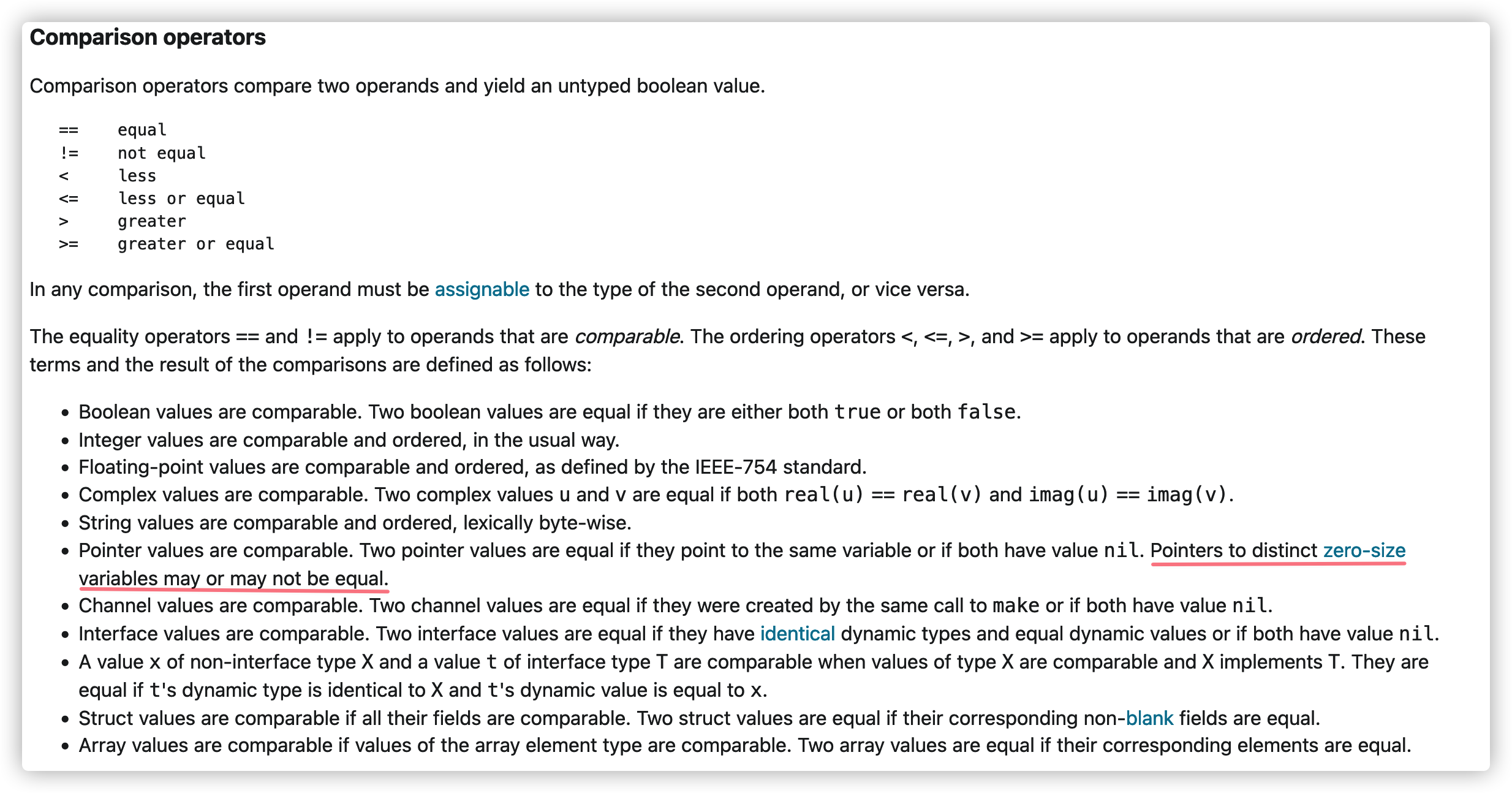空结构体 #
空结构体指的是没有任何字段的结构体。
大小与内存地址 #
空结构体占用的内存空间大小为零字节,并且它们的地址可能相等也可能不等。当发生内存逃逸时候,它们的地址是相等的,都指向了 runtime.zerobase。
// empty_struct.go
type Empty struct{}
//go:linkname zerobase runtime.zerobase
var zerobase uintptr // 使用go:linkname编译指令,将zerobase变量指向runtime.zerobase
func main() {
a := Empty{}
b := struct{}{}
fmt.Println(unsafe.Sizeof(a) == 0) // true
fmt.Println(unsafe.Sizeof(b) == 0) // true
fmt.Printf("%p\n", &a) // 0x590d00
fmt.Printf("%p\n", &b) // 0x590d00
fmt.Printf("%p\n", &zerobase) // 0x590d00
c := new(Empty)
d := new(Empty)
fmt.Sprint(c, d) // 目的是让变量c和d发生逃逸
println(c) // 0x590d00
println(d) // 0x590d00
fmt.Println(c == d) // true
e := new(Empty)
f := new(Empty)
println(e) // 0xc00008ef47
println(f) // 0xc00008ef47
fmt.Println(e == f) // flase
}
从上面代码输出可以看到 a, b, zerobase 这三个变量的地址都是一样的,最终指向的都是全局变量runtime.zerobase(
runtime/malloc.go)。
// base address for all 0-byte allocations
var zerobase uintptr
我们可以通过下面方法再次来验证一下 runtime.zerobase 变量的地址是不是也是0x590d00:
go build -o empty_struct empty_struct.go
go tool nm ./empty_struct | grep 590d00
# 或者
objdump -t empty_struct | grep 590d00
执行上面命令输出以下的内容:
590d00 D runtime.zerobase
# 或者
0000000000590d00 g O .noptrbss 0000000000000008 runtime.zerobase
从上面输出的内容可以看到 runtime.zerobase 的地址也是 0x590d00。
接下来我们看看变量逃逸的情况:
go run -gcflags="-m -l" empty_struct.go
# command-line-arguments
./empty_struct.go:15:2: moved to heap: a
./empty_struct.go:16:2: moved to heap: b
./empty_struct.go:18:13: ... argument does not escape
./empty_struct.go:18:31: unsafe.Sizeof(a) == 0 escapes to heap
./empty_struct.go:19:13: ... argument does not escape
./empty_struct.go:19:31: unsafe.Sizeof(b) == 0 escapes to heap
./empty_struct.go:20:12: ... argument does not escape
./empty_struct.go:21:12: ... argument does not escape
./empty_struct.go:22:12: ... argument does not escape
./empty_struct.go:24:10: new(Empty) escapes to heap
./empty_struct.go:25:10: new(Empty) escapes to heap
./empty_struct.go:26:12: ... argument does not escape
./empty_struct.go:29:13: ... argument does not escape
./empty_struct.go:29:16: c == d escapes to heap
./empty_struct.go:31:10: new(Empty) does not escape
./empty_struct.go:32:10: new(Empty) does not escape
./empty_struct.go:35:13: ... argument does not escape
./empty_struct.go:35:16: e == f escapes to heap
可以看到变量 c 和 d 逃逸到堆上,它们打印出来的都是 0x591d00,且两者进行相等比较时候返回 true。而变量 e 和 f 打印出来的都是0xc00008ef47,但两者进行相等比较时候却返回false。这因为Go有意为之的,当空结构体变量未发生逃逸时候,指向该变量的指针是不等的,当空结构体变量发生逃逸之后,指向该变量是相等的。这也就是
Go官方语法指南 所说的:
Pointers to distinct zero-size variables may or may not be equal

Go语言比较操作符比较规则
注意:
不论逃逸还是未逃逸,我们都不应该对空结构体类型变量指向的内存地址是否一样,做任何预期。
当一个结构体嵌入空结构体时,占用空间怎么计算? #
空结构体本身不占用空间,但是作为某结构体内嵌字段时候,有可能是占用空间的。具体计算规则如下:
- 当空结构体是该结构体唯一的字段时,该结构体是不占用空间的,空结构体自然也不占用空间
- 当空结构体作为第一个字段或者中间字段时候,是不占用空间的
- 当空结构体作为最后一个字段时候,是占用空间的,大小跟其前一个字段保持一致
type s1 struct {
a struct{}
}
type s2 struct {
_ struct{}
}
type s3 struct {
a struct{}
b byte
}
type s4 struct {
a struct{}
b int64
}
type s5 struct {
a byte
b struct{}
c int64
}
type s6 struct {
a byte
b struct{}
}
type s7 struct {
a int64
b struct{}
}
type s8 struct {
a struct{}
b struct{}
}
func main() {
fmt.Println(unsafe.Sizeof(s1{})) // 0
fmt.Println(unsafe.Sizeof(s2{})) // 0
fmt.Println(unsafe.Sizeof(s3{})) // 1
fmt.Println(unsafe.Sizeof(s4{})) // 8
fmt.Println(unsafe.Sizeof(s5{})) // 16
fmt.Println(unsafe.Sizeof(s6{})) // 2
fmt.Println(unsafe.Sizeof(s7{})) // 16
fmt.Println(unsafe.Sizeof(s8{})) // 0
}
当空结构体作为数组、切片的元素时候:
var a [10]int
fmt.Println(unsafe.Sizeof(a)) // 80
var b [10]struct{}
fmt.Println(unsafe.Sizeof(b)) // 0
var c = make([]struct{}, 10)
fmt.Println(unsafe.Sizeof(c)) // 24,即slice header的大小
用途 #
由于空结构体占用的空间大小为零,我们可以利用这个特性,完成一些功能,却不需要占用额外空间。
阻止unkeyed方式初始化结构体
#
type MustKeydStruct struct {
Name string
Age int
_ struct{}
}
func main() {
persion := MustKeydStruct{Name: "hello", Age: 10}
fmt.Println(persion)
persion2 := MustKeydStruct{"hello", 10} //编译失败,提示: too few values in MustKeydStruct{...}
fmt.Println(persion2)
}
实现集合数据结构 #
集合数据结构我们可以使用map来实现:只关心key,不必关心value,我们就可以值设置为空结构体类型变量(或者底层类型是空结构体的变量)。
package main
import (
"fmt"
)
type Set struct {
items map[interface{}]emptyItem
}
type emptyItem struct{}
var itemExists = emptyItem{}
func NewSet() *Set {
set := &Set{items: make(map[interface{}]emptyItem)}
return set
}
// 添加元素到集合
func (set *Set) Add(item interface{}) {
set.items[item] = itemExists
}
// 从集合中删除元素
func (set *Set) Remove(item interface{}) {
delete(set.items, item)
}
// 判断元素是否存在集合中
func (set *Set) Contains(item interface{}) bool {
_, contains := set.items[item]
return contains
}
// 返回集合大小
func (set *Set) Size() int {
return len(set.items)
}
func main() {
set := NewSet()
set.Add("hello")
set.Add("world")
fmt.Println(set.Contains("hello"))
fmt.Println(set.Contains("Hello"))
fmt.Println(set.Size())
}
作为通道的信号传输 #
使用通道时候,有时候我们只关心是否有数据从通道内传输出来,而不关心数据内容,这时候通道数据相当于一个信号,比如我们实现退出时候。下面例子是基于通道实现的信号量。
// empty struct
var empty = struct{}{}
// Semaphore is empty type chan
type Semaphore chan struct{}
// P used to acquire n resources
func (s Semaphore) P(n int) {
for i := 0; i < n; i++ {
s <- empty
}
}
// V used to release n resouces
func (s Semaphore) V(n int) {
for i := 0; i < n; i++ {
<-s
}
}
// Lock used to lock resource
func (s Semaphore) Lock() {
s.P(1)
}
// Unlock used to unlock resource
func (s Semaphore) Unlock() {
s.V(1)
}
// NewSemaphore return semaphore
func NewSemaphore(N int) Semaphore {
return make(Semaphore, N)
}